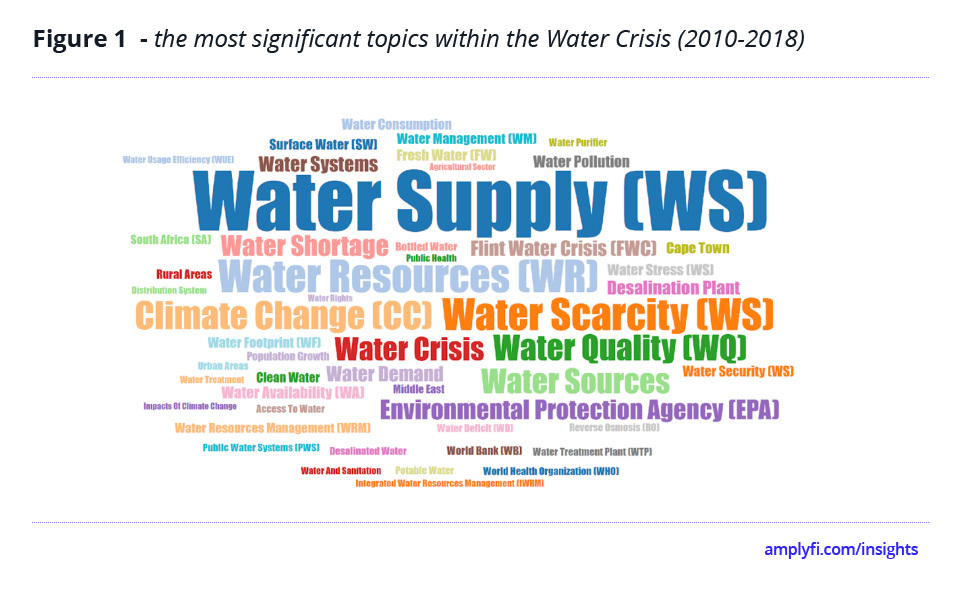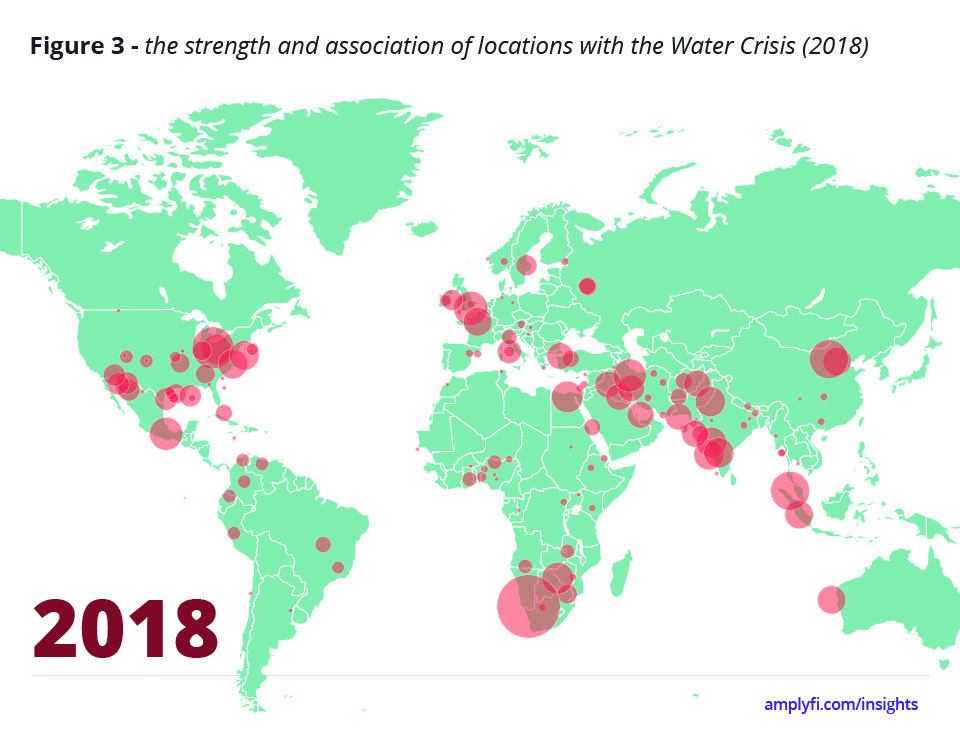
World Water Day, held on 22nd March, celebrates water and raises awareness of the billions of people living without access to safe water. A UN observance day, it highlights the importance of freshwater and reinforces the message of taking action to tackle the global water crisis.
Like almost every aspect of life, the realities of water sustainability have been altered in the past year due to the coronavirus pandemic. This World Water Day, AMPLYFI is investigating the reality of water sustainability and sanitation in the aftermath of COVID-19.
Using AMPLYFI’s AI platform, we have analysed documents from the Deep Web and found a number of concerning factors related to water sustainability and sanitation following COVID-19. The below word cloud indicates the most significant topics within the water crisis found by AMPLYFI’s platform.
According to the United Nations and the World Health Organisation, 1.1 billion people in the world are without water access, with another 2.7 billion suffering from water scarcity at least once a month. Within the context of a global pandemic, this means over 3.8 billion people cannot leverage handwashing as a defence tactic against COVID-19.
A key driver of water scarcity is population growth, which leads to factors such as increased demand, climate change, unsustainable use of aquifers, a surge in aquatic leisure facilities, pollution and poor sanitation. UN statistics estimate 5.7 billion people globally will deal with chronic water shortages by 2025.
COVID-19 greatly compounds the challenges of water sustainability and sanitation. The first point of impact the pandemic had was demand. COVID control measures, such as lockdowns and travel restrictions, resulted in a decline in water demand for industrial or commercial use and a simultaneous upsurge in residential demand. For instance, in the cosmopolitan port city of Portsmouth, England, residential demand increased by 15%, and non-residential declined by 17%.
Though demand patterns resumed to pre-COVID levels in most countries by June 2020, the financial implications, especially on utility companies, will last much longer. In Florida, for example, the Toho Water system projected an annual revenue loss of 9% following a 52% reduction in commercial water use and a 12.5% drop in reclaimed water sales during the first six months of 2020.
In the first few months of the pandemic, governments implemented financial and social relief measures to protect citizens from economic hardship. Through a “Declaration of Catastrophe” the government in Chile deferred water and sanitisation bills for half of the poorest citizens for six months. The Chileans were to pay the deferred amounts at a later date in instalment without interest or penalties.
The government in Ghana declared free water, electricity and a host of tax relief measures for three months from July 2020. In Brazil, a local water utility company gave a three-month tariff exemption to low-income households and postponed tariff adjustments for another three months.
Due to such interventions, water utility companies, most of whom already faced cash flow problems, experienced a 15% decline in revenue in 2020. This fall is due to utility companies subsidising the cost of household water with income from sales to industries. Therefore, the relief measures and the demand changes negatively affected their ability to maintain profitability, provide quality and affordable water and sanitation services to residents.
The second point of impact of the coronavirus pandemic is an expected health risk associated with the water from municipal water systems that had to be left stagnant during lockdowns. Typically, the flow of safe, disinfected municipal tap water staves off bacteria, corrosion, and leached minerals. However, with water systems shut down for months, the chlorine residuals dissolve, making the water vulnerable to recontamination. Such realities coupled with the CDC concerns of raising waterborne illnesses in the United States due to ageing infrastructure, unregulated water systems such as private wells and chlorine-tolerant and biofilm-related pathogens compound the underlying issues behind the increase in waterborne diseases.
Globally, one in three people don’t have adequate sanitation. In Europe, 32 million people lack access to basic sanitation, 48 million do not have piped water at home, and over 300,000 people practice open defecation. Poor sanitation exposes 2.4 billion people to waterborne illnesses, and two million children die every year from diarrheal diseases alone. On a global scale, the water crisis continues to worsen, with a growth in strength and association seen in multiple locations from 2010 to 2018.
With COVID-19 there has been an unprecedented increase in hazardous biomedical waste. In China, for instance, the increase in medical waste from personal protective equipment like gloves, face masks, aprons and eye protection has increased hospital medical waste six times. The influx of COVID patients in China led to the construction of additional waste plants and 46 mobile waste treatment facilities. In Barcelona, medical waste increased by 350% to 1,200 from 250 metric tonnes between march and November 2020.
The nature of Coronavirus means that duty bearers must regard COVID medical waste as hazardous and implement a waste management process that avoids environmental contamination. However, the pandemic’s novelty means that governments are yet to design responsive policies to address the challenge of dangerous biomedical waste management in emergency pandemic situations.
For instance, most countries are yet to provide legislation or guidelines to monitor the importation or exportation of potentially COVID-19 contaminated waste. Even more concerning, governments don’t have guidelines for municipalities on how to sort between waste from COVID contaminated households and those from non-contaminated households.
Further, reports indicate COVID viral fragments have been detected in human excrement and wastewater, even in communities with only asymptomatic COVID-19 cases. Scientists in the UK and Poland established that SARS-CoV-2 lasts up to 25 days in water, with infection risk through contaminated water varying depending on environmental conditions. In Ecuador, SARS-CoV-2 was found in the rivers whose course passes through Quito, the country’s capital city. The risk of waterborne transmission of COVID is very high in countries with poor sanitation. In such situations, measures such as handwashing and quarantine will no longer be effective, resulting in severe consequences for these countries and the global community.
Now more than ever, policymakers and other actors must consider sanitation practices in light of COVID transmission risk factors. And the circular economy approach for sanitation, tried and tested in India with significant success, offers the most viable solution.
The circular economy of water and sanitation is a plausible approach that addresses the sanitation challenges even with COVID-19. Its emphasis is on presenting sanitation as a commercially viable business endeavour, thus attracting investment. The model provides incentives for individuals, communities or entrepreneurs to collect and treat human excreta and produce commercially viable products such as soil conditioners used in agriculture.
This circular economy encourages a non-linear use of water not exclusively as either a carrier (of nourishing minerals), a service (for sanitation, domestic and commercial uses) or an energy source (hydro-electric power), but focuses on opportunities for the confluence of uses. For instance, in cities, wastewater can be used as both a carrier of organic waste and simultaneously harnessed as a thermal power source. The expanded use means people withdraw less water from sources such as rivers, streams and aquifers, giving them time to replenish.
However, there is still a long way to go before countries can begin to leverage the opportunities presented by the circular economy approach. One main challenge is the lack of policies to guide the confluences of water consumption and the sale or use of human excreta derived fertiliser.











